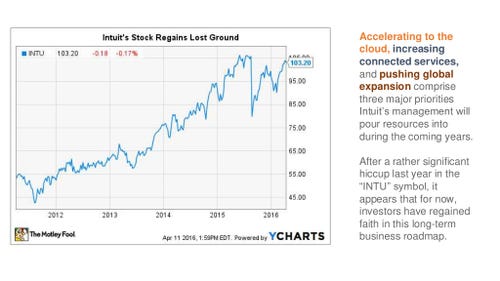Intuit: How a "33-Year-Old Startup" Plans to Use the Cloud to Reinvent Itself
Intuit is betting on cloud software to take it to its next level of growth. Here are two lessons for your business.

As Intuit comes off of its sale of Quicken to a private equity firm, the Silicon Valley company is betting on cloud software to take it to its next level of growth, according to a report this week by the New York Times.
The company is certainly not a sexy startup in the cloud space; it’s been around for more than 30 years. Sexy or not, the returns on Intuit’s stock have been larger and more consistent than for Microsoft or Oracle, according to UBS analyst Brent Thill.
In an interview with the Times, Intuit CEO Brad D. Smith said that giving up Quicken was difficult, but in trying “to live up to being a 33-year-old startup” it was a necessary decision to invest in its online versions instead.
Aside from investing in its PC versions in lieu of improving its online versions, it neglected a major opportunity in expanding outside North America. Xero, a 10-year-old company based in New Zealand grabbed this opportunity, and by focusing on simplicity, was able to disrupt the industry. According to the Times, this pushed Intuit to overhaul its online product, including an open app platform, and invest in some international markets.

One of the challenges that remain is converting existing QuickBooks customers over to the online version, according to the report. But it is working on it – the company finished the quarter ended Jan. 31 with 1,257,000 subscribers to QuickBooks Online, a 49 percent increase from the previous year. Intuit wants to reach 2 million subscribers by end of fiscal year 2017.
So what can you learn from Intuit in this case? First, never get too comfortable. You should consistently be looking for new opportunities and assessing upcoming threats and competitors – even if they’re upstarts. The last thing you want is to move too slowly and have someone else who is more agile snatch up an opportunity. (This includes international expansion. We’ve got some tips on how to successfully navigate a global expansion here.)
Second, when marketing a new product or service, don’t forget about your existing customers. You already have a relationship with them, they trust you, and they like what you have to offer. Consider how your marketing organization can educate existing customers on new offerings to support sales.
About the Author
You May Also Like


